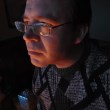1⁄48AVENGER 93 Loyce Deen 353
Page 6
Now that we knew which flight plan to travel the correct markings began to flow in. Bits from this sheet and others from that sheet would complrise the look we were aiming towards. The only issue was the 353 markings. Brian did a super job looking into this area and was important because it would determine the correct serial number. There is another kit manufacturer that make the 353 but they have the incorrect serial number, if I recall properly. In fairness though one book has this number and another book that number. In the end he determined which book was more accurate. As you can see by the photo making your own number is not fun nor is accurate and these little guys wanted to drift all over the place in the decal fluid. You can imagine my delight at getting the correct number, in the correct font and size. Next it was my job to replicate the 353 badge. The aftermarket decals that have this insignia look ok yet have a noticeable dot pattern in the print. As I've done before the images was traced from my computer screen then cut out to make the template.When most of the decals were in place and clear coated it was time for a pin wash and panel line staining. 502 oils would be best for this project because they can give a cleaner more defined appearance. The look of this aircraft needed to be fairly clean.
At long last there was a completed fuselage and while not 100% accurate it would fit the bill. Now this bird needed some wings but there was still that subject of the walkways. Both of us had settled on no walkways until I watched for a hundredth time the Loyce Deen burial at sea video. Like I said earlier there was only a few seconds of the plane being pushed into the sea when the wings came to an angle that reflected the sun and clearly showed the walkways. Brian put it best by saying, "Oh those bloody walkways!". I would have chosen different words.
When it came time to attaching the wings a few things needed to be done. First was cleaning out the paint coats from the wing root and test fitting the flaps to make sure they cleared the inside at that root. Some slight adjustments with removing plastic had to be made for the wings to sit flush. I'll say this for the record, Accurate Miniatures got it right by adding the spars because the dihedral was spot on and perfect on both sides... something all aircraft modelers fret over. After plugging one in I made a stand so there would be less handling and it could left alone to dry. Again, crude looking but who cares, so long as the model looks good I could care less what the supporting tools look like.
Sooner or later the rocket launcher posts had to be done. They remind me of teeth and completin' em' was just like a pullin' em'. The goal was to replicate the stamped metal look with release shackles and base plate. Essentially they're a few layers of left over sheet parts cemented together and sanded/filed until they matched the masters. Then some sprue was stretched to simulate the folded metal and a razor saw cut the necessary notches. The back posts have a different look and have the ignition plug. Then some polystyrene filler (sprue goo) got painted on and later they were sanded smooth. Sadly you get to a point where things are just too small to handle and thus impractical to fully recreate in this scale. All that belly aching put in its place they look decent, are spaced properly and infinitely better than the parts offered by another version of this Avenger and by other manufacturers.
Some fun came back into the build with small details being completed such as the pin wash of the remaining parts and splitting the bomb bay doors. Also the cowl flaps need to be bent and weathered. One thing I've learned is to have a thorough walk around to see if some panel lines or rivets needed to be fixed or touch-up painting. This is done prior to the final clear coats and I've always found something to address. It's a good practice to get into and relieves a load of possible stress later.
There are two types of clear coat on this model in various places. The leading edges are a different color and a flat coat while the wing tops are semi gloss. The fuselage sides are mat while the upper section is semi gloss. Any variations in these would come with the oil stains for the different fluid leaks. The wing tops did come out a bit glossier due to the finish in the paint itself. Overall there is plenty of differences for the eye to enjoy. Unfortunately it's something the camera does little justice too.
Copyright ©2021 by HG Barnes. Images also by copyright holder unless otherwise noted. The views and opinions expressed herein are solely the views and opinions of the authors and/or contributors to this Web site and do not necessarily represent the views and/or opinions of AeroScale, KitMaker Network, or Silver Star Enterrpises. Images also by copyright holder unless otherwise noted. Opinions expressed are those of the author(s) and not necessarily those of AeroScale. All rights reserved. Originally published on: 2020-01-25 00:00:00. Unique Reads: 6833




.JPG)
.JPG)
.JPG)
.JPG)
.JPG)
.JPG)
.JPG)
.JPG)
.JPG)
.JPG)
.JPG)
.JPG)
.JPG)
.JPG)
.JPG)
.JPG)
.JPG)
.JPG)
.JPG)
.JPG)
.JPG)
.JPG)
.JPG)
.JPG)
.JPG)
.JPG)




